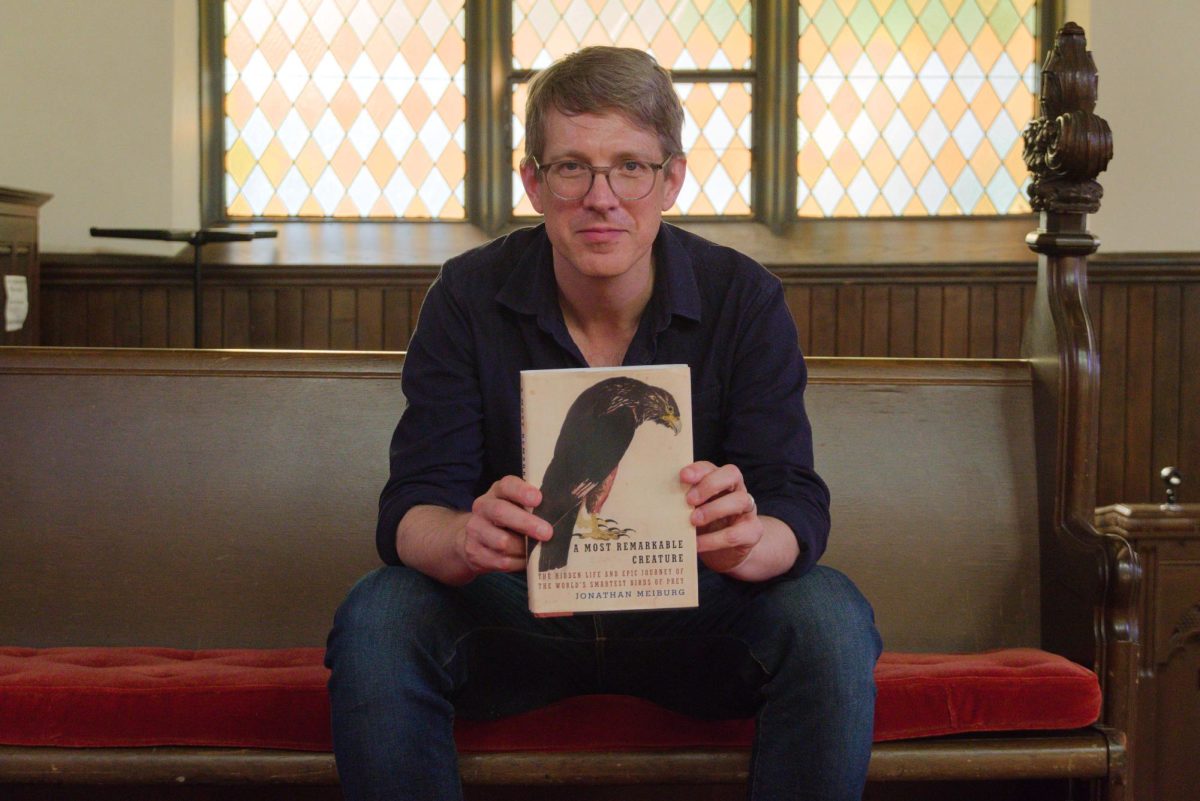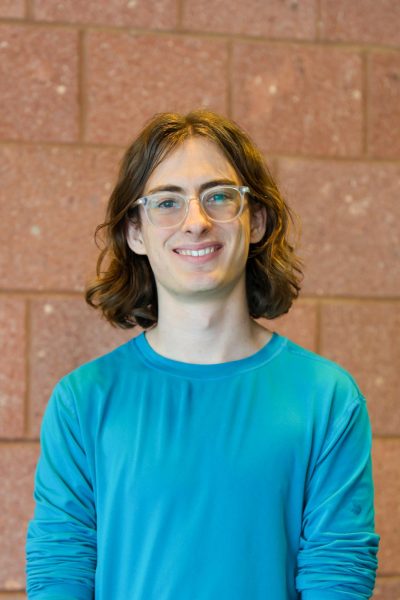Typically, Writers@Grinnell brings writers on campus for a day to do a roundtable discussion in the afternoon, followed by a literary reading in the evening. Jonathan Meiburg, however, joined Grinnell for a three-day, five-event series from Wednesday, Sept. 18 to Friday, Sept. 20, 2024.
Director of W@G and associate professor of English Hai-Dang Phan’s own interest in birding led him to Meiburg’s first published book, “A Most Remarkable Creature: The Hidden Life of the World’s Smartest Birds of Prey.” This book centers the evolution and threat to caracaras, birds of prey from the Falklands to southern Guyana.
Hosted by W@G and co-sponsored with the Center for Prairie Studies, the Environmental Studies concentration and the Grinnell College Birding Club (GCBC), Meiburg gave an art and sciences talk in the Humanities and Social Sciences Center (HSSC) on Wednesday, conversed with Phan’s American Environmental Literatures class on Thursday, gave a literary reading at Herrick Chapel later that Thursday, had lunch with students Friday afternoon and topped it off with the nature walk at the Conard Environmental Research Area (CERA) Friday evening.
Graduating from University of the South in 1997 as an English major, Meiburg was awarded the Thomas J. Watson Fellowship, a program that brings newly college graduates around the world for a year. Meiburg ventured to study “community life at ends of the earth.” He had not left the southeastern United States before this.
While in a remote part of the Falkland Islands, one of his roommates introduced him to birding. These caracaras — birds that appear like “ten separate attempts to build a crow on a falcon chassis,” as Meiburg puts it in his book — would come to be his gateway bird.
“Communicating the Harmonies of Art and Science” Talk at the HSSC
Walking up the steps of the tiered classroom, Meiburg goes to shut the lights as he’s reading off his script. These caracaras warrant steady musical notes that go up and curve into question marks in the backdrop.
Since it is 7 p.m., the biggest light source comes from the two projection screens up at the front, the left a picture slideshow, the right the Janus Films logo. We might imagine Meiburg as an investigator and caracaras as suspects.“Why are you like this? Why are there so few of you? How did you come to be?” he asks, sharing the same questions as his interlocutor from two centuries ago Charles Darwin, also intrigued with caracaras.
He speaks to us about the interconnectedness of the universe, humans sharing some percentage of DNA with bananas and tapeworms alike, he brings us to the interconnectedness of art and science, both equally essential in their methods and outputs, both in constant doubt of something.
“Living without music just doesn’t seem to be something our species likes to do,” said Meiburg, also lead singer for indie rock band Shearwater.
Living without music seems to be difficult — so difficult that some salsa music from right outside continued to seep into the room half an hour into Meiburg’s performance. In fact, he himself did not want to give up music so much he sacrificed a PhD in Biology for it.
W@G Reading at Herrick Chapel
In his introduction of the writer, Phan reflects on Meiburg’s Wednesday talk. The W@G director is reminded of evolutionary biologist E.O. Wilson’s definition of biophilia.
“Wilson argues that our natural affinity for life — biophilia — is the very essence of our humanity and binds us to all other living species,” he says.
On the pulpit, Meiburg shares that he will be reading an extract from section two of his book. He tells about his first time exploring southern Guyana, “secretly [his] favorite part of the book,” culminating in an encounter with arachnids.
He, then, reads an excerpt from his second book “The Secret Land: The Once and Future Life of Antarctica” that is a work in progress on the richness of the Southern Ocean floor. He is set to go to Antarctica for the first time next year.
Nature Walk at CERA
In the state of Iowa, known for its flatness and monoculture, CERA remains a pocket of biodiversity and restored prairie land.
Emma Daugherty `28, from North Carolina, said she was initially intimidated by Meiburg’s expertise. She came into the College with the goal of studying birds and go into conservation. Yet, after encountering Iowa birds at a bird banding event, distinct from southeastern U.S. birds, she said she became insecure about her identity as a birder.
Meiburg, however, reminded her of how birds indicate place, the variability of birds inherent to placemaking. Each new place means more birds to seek.
On the trail by Perry Pond, Meiburg and Daugthery spot flashes of a bird among the trees to their left. Hearing a squawk, they theorize that it is a blue jay. Once a red head becomes clear, it is a red-headed woodpecker. In fact, they see two. For Daughtery, one of three “lifers,” a term birders use to describe a bird species they have seen for the first time, she had seen on this trip; For Meiburg, a bird he hasn’t seen in years.
And though Meiburg has seen many birds in his time, Phan commenting on how Meiburg is as a birder said, “You sort of get the sense with him that everything is rare.”
Both inspiring awe and being submerged in it himself, he revels in what he calls a “generative space of not-knowing,” a reminder of possibility derived in naïvete.
On October 10th, 2024, the next W@G event will host Bruna Dantas Lobato, assistant professor of English at the College, at 4:15 p.m. in the Joe Rosenfield Center (JRC) room 101 to celebrate the release of her new novel “Blue Light Hours.” On November 14th, 2024, poet Eduard C. Corral will do a roundtable at 4:15 p.m. at the Humanities and Social Sciences Center (HSSC) room S1325, followed by a reading in JRC 101 at 8 p.m.


















































